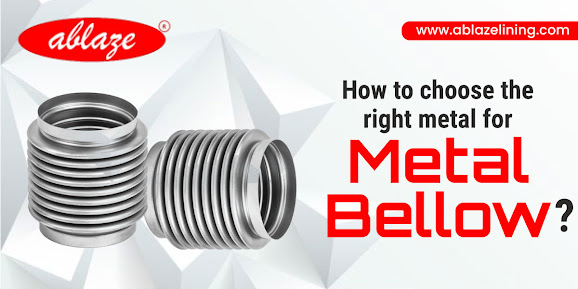How to choose the right metal for Metal Bellow?
Metal bellows are flexible containers that can be shrunk when external pressure is applied and expanded when a vacuum is provided. If the material has not been stretched beyond its yield strength, the bellows will revert to their original shape when the pressure is released. They serve dual purposes just like a hermetic seal permitting movement as well as a means of deformation under pressure.
In the 20th and 21st centuries, metal bellows have been the focus of precision bellows technology, while rubber and plastic bellows have been used for less demanding applications. There is little resemblance between these and the old leather bellows used to blow air into furnaces and forges. Ablaze Lining is an excellent and the most distinguished High Pressure Bellow supplier in Bhuj that can fulfil all of your pressure bellow needs.
Types of Metal Bellows:
Four types of Metal Bellows are;
- Formed
- Welded
- Hydroformed
- Electroformed
- Bellows are made via cold forming (rolling), hydroforming, and other procedures after tubes have been made via deep drawing. It's also possible to refer to them as sylphons or twisted bellows.
- Producing welded bellows involves welding together a series of diaphragms that have been made separately. Cost and efficiency are the two primary metrics used to evaluate the two bellows options.
- Despite a hefty initial investment in machinery, hydroformed bellows may end up being less expensive per unit if they are manufactured in bulk. Hydroformed bellows, on the other hand, have subpar performance characteristics because of their large walls and high rigidity. Production tooling costs for welded bellows that are made from metal are lower than those for other materials, and their performance qualities are stable throughout time. Welded bellows have a disadvantage in that the high welding temperature weakens the metal at the weld joints.
- Electroforming involves plating a metal layer over a model and then removing the mandrel to reveal the finished electroformed bellows. Such bellows can be made with cheap tooling costs and thin walls, making them sensitive and precise in many demanding applications; furthermore, they can be made in geometries that would be extraordinarily difficult to make in any other way.
Welded bellows can be made from a
wider range of standard and exotic alloys, including stainless steel, titanium,
and other high-strength, corrosion-resistant materials, whereas hydroformed and
rolled bellows are confined to metals that possess characteristics like high
plastic elongation. Nickel along with its robust alloys, as well as copper are
all suitable materials for electroforming into bellows. If you are looking for
the best quality High Pressure Bellow in
Vadodara, Ablaze Lining is the best pick for you.
How to choose the right metal for Metal Bellow?
A wide range of metals, including bronze, brass,
Monel, beryllium copper, as well as stainless steels, are used to make bellows.
Depending on the task at hand, each has its uses. Here's a rundown of when each
type of material should be used:
●
Brass:
Brass is a common and durable bellows
material because it is inexpensive to produce and can be easily joined with
modern lead-free solders. Brass bellows can withstand temperatures up to 300°F
(150°C) in the air. Thermostatic control assemblies, as well as Mechanical
altimeters, are two such examples.
●
Bronze:
The manufacturing cost of bronze is
minimal, and it has superior properties over brass in terms of tensile
strength, corrosion resistance, and electrical conductivity. While bronze
solders can be used in the same ways that brass solders may, they can also be
brazed, making them capable of withstanding high-temperature environments.
Bellows made of bronze are frequently found in home appliances and heating and
cooling systems because of their durability and reliability in high-volume
settings.
●
Beryllium Copper:
When compared to the other bellows
materials, beryllium copper (BeCu) excels in robustness as well as electrical
conductivity. It is solderable and brazeable. For maximum dimensional stability,
bellows assemblies frequently include age-hardened beryllium copper.
Applications with stringent lifetime and minimal package size requirements
favour beryllium copper bellows. Aerospace systems and instruments are two
examples.
●
Monel:
Monel, a nickel alloy, is superior to
brass, bronze, and beryllium copper in terms of its resistance to corrosion.
Welding is the most common method for joining Monel, however, brazing is also
possible. The mechanical properties of Monel are comparable to bronze's, making
it a popular choice for use in corrosive conditions like those found in salt
water or steam.
●
Stainless Steels:
Most bellows are made from 300 Series
stainless steel, however other grades of stainless steel are also used.
Stainless steel's high tensile strength allows for more stroke while requiring
less space in transit or storage. Additionally, stainless steels have a high
level of resistance to corrosion in a wide variety of conditions and media.
Stainless steel bellows can tolerate high temperatures and are usually brazed
or welded together. Uses for stainless steel bellows extend beyond the
electrical industry and into power transmission and industrial control systems.
Ablaze Lining is the most prominent as well as noteworthy High
Pressure Bellow distributor in Vadodara.
●
Nickel:
Nickel's durability and resistance to
corrosion make it a desirable material. Nickel is used to making
electrodeposited bellows, but it is also applied to other types of bellows to
protect them against corrosion. The aerospace industry makes extensive use of
nickel.



Comments
Post a Comment